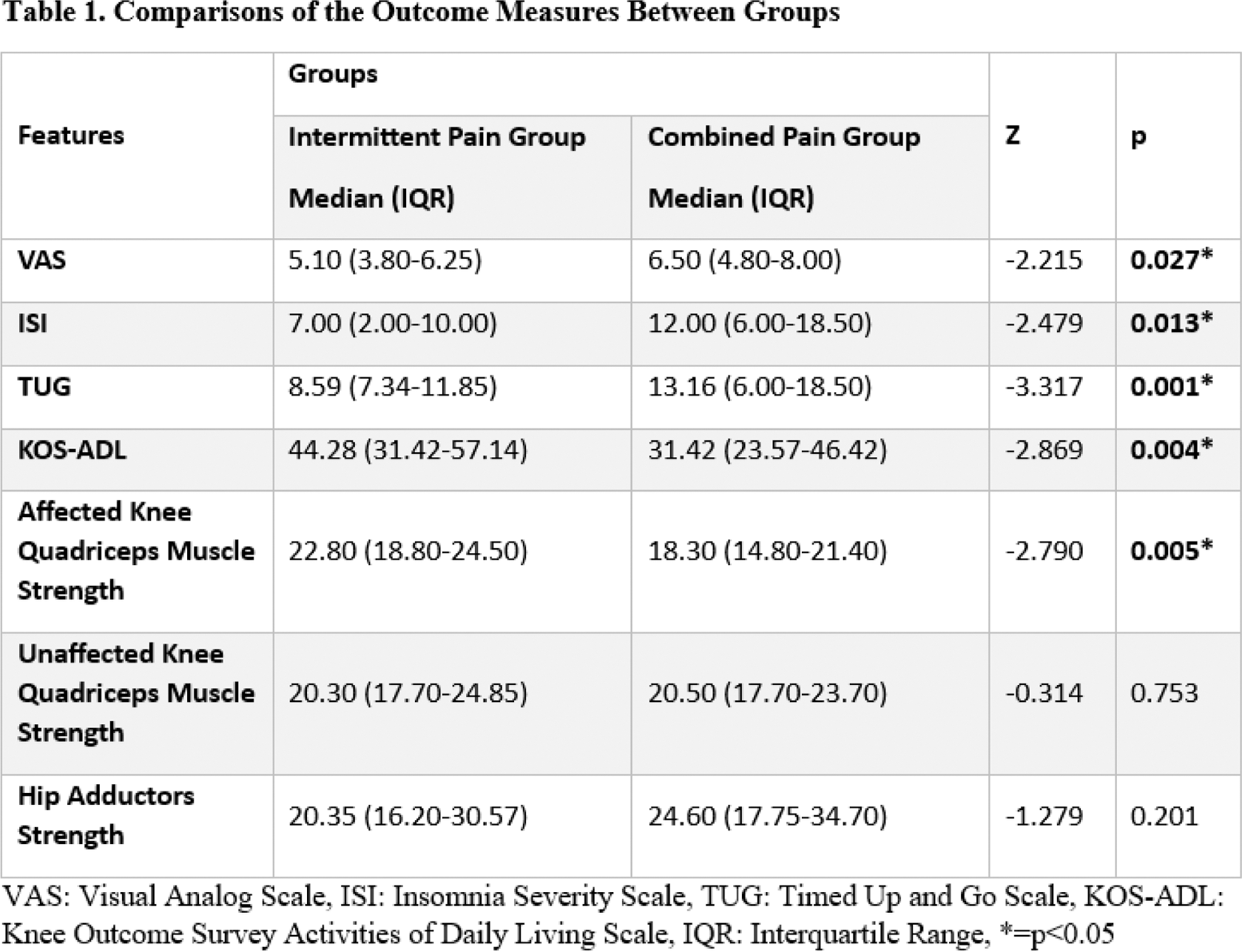

Background: It is known that pain in patients with knee osteoarthritis (OA) can present as intermittent, constant or both intermittent and constant (combined). Moreover, while pain in patients with early-stage knee OA tends to be intermittent, it has been shown that as the severity of knee OA increases, the pain becomes constant or combined.
Objectives: The objective of our study was to investigate the effect of pain characteristics on insomnia, knee function, functional performance, and muscle strength in patients with knee OA.
Methods: A total of 66 patients with primary knee OA, aged between 50 and 81 years, were included in the study. Patients were divided into two groups: the intermittent pain group (n=33 (31 Females; 2 Males), mean age 64.52±8.65 years) and the combined pain group (n=33 (30 Females; 3 Males), mean age 67.09±6.75 years). The patients included in the study had Grade 2 (n=8, 12.1%), Grade 3 (n=37, 56.1%) and Grade 4 (n=21, 31.8%) knee OA according to Kellgren-Lawrence OA classification. Sociodemographic data such as age, gender and BMI and disease severity was obtained from all participants. The Intermittent and Constant Pain Score (ICOAP) was used to determine the pain characteristics. Pain severity was assessed by Visual Analog Scale (VAS); insomnia severity was assessed with Insomnia Severity Index (ISI); knee function and functional performance was assessed by Knee Outcome Survey Activities of Daily Living Scale (KOS-ADL) and Timed Up and Go Test (TUG). Additionally, a pneumatic dynamometer was used to evaluate the isometric quadriceps muscle strength of both knees. SPSS 26.0 was used for statistical analysis. p<0.05 was considered statistically significant.
Results: There was no significant difference between groups in terms of gender (p=0.395), age (p=0.253), BMI (p=0.868), and the grade of knee OA (p=0.202). The mean ICOAP score of individuals in the intermittent pain group was 13.73±5.87, and in the combined pain group ICOAP score was 28.67±9.52. There was statistically significant difference between groups in VAS, with the intermittent pain group showing lower pain intensity (p=0.027). The TUG (p=0.001), ISI (p=0.013), KOS-ADL (p=0.004), and affected knee quadriceps muscle strength (p=0.005) were all significantly better in the intermittent pain group. However, no significant differences were found between groups in the quadriceps muscle strength of the unaffected knee (p=0.753) and the hip adductor muscle strength (p=0.201) (Table 1).

Conclusion: The results of our study showed that knee function, functional performance, insomnia severity and affected knee Quadriceps muscle strength were all better in patients with intermittent knee pain compared to those with combined knee pain in knee OA. The findings of this study also suggest that pain severity is influenced by the pain characteristics. In conclusion, pain has different characteristics beyond its severity, and these pain characteristics -whether intermittent or combined- can influence outcome measures such as insomnia severity, knee function and functional performance which may affect the severity of the disease in patients with knee OA. Additionally, the results of this study demonstrated that pain characteristics affect the symptoms of the disease, independent of its radiological severity. Therefore, we believe that in the rehabilitation of patients with knee OA, healthcare professionals should not only focus on pain severity, but also consider the pain characteristics as part of the pain assessment.
REFERENCES: [1] Hawker GA, Stewart L, French MR, Cibere J, Jordan JM, March L, et al. Understanding the pain experience in hip and knee osteoarthritis--an OARSI/OMERACT initiative. Osteoarthritis Cartilage. 2008;16(4):415-22.
[2] Carlesso LC, Hawker GA, Torner J, Lewis CE, Nevitt M, Neogi T. Association of Intermittent and Constant Knee Pain Patterns with Knee Pain Severity and With Radiographic Knee Osteoarthritis Duration and Severity. Arthritis Care Res (Hoboken). 2021;73(6):788-93.
Acknowledgements: NIL.
Disclosure of Interests: None declared.
© The Authors 2025. This abstract is an open access article published in Annals of Rheumatic Diseases under the CC BY-NC-ND license (